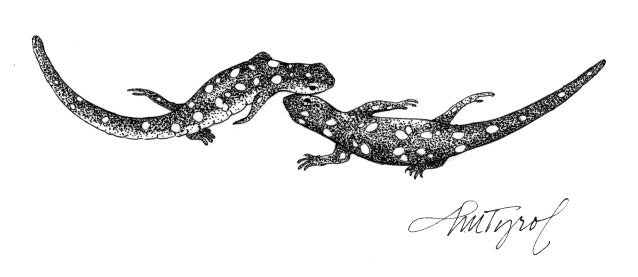
When April temperatures reach 45 degrees Fahrenheit and a long rain extends into the evening, spotted salamanders are awakened by water trickling through the forest soil. They push their way up through the earth and, guided by gravity and a moisture gradient, begin their annual migration down to vernal pools. Vernal pools (literally “spring” pools) are ephemeral. Filled with snow-melt and rain in the spring, they are dry by mid-summer. Spotted salamanders depend on vernal pools because they contain no fish, which feed on salamander eggs, tadpoles, and even adults. Once the six- to eight-inch spotted salamanders reach the water, their dance begins.
The number of salamanders in a single vernal pool can be extraordinary. One year on April 17, in a pool in Norwich, a congress of more than 50 male spotted salamanders –their yellow spots gleaming in the beam of my flashlight – twisted and turned on a mat of drowned red maple leaves. When the first female arrived, she approached the group and picked a mate. The two swam away to a less crowded section of the pool and began to circle, cheek to cheek like spinning square dance partners.
Half an hour later, the male broke away. I followed him with my light to a shallower section of the pool. Here he deposited white conical packets of sperm (spermatophores) on the bottom of the pool. He interupted this activity twice to rise to the surface for air – legs folded against his sides, propelled by his twisting body and tail.
When the last spermatophore was in place, he swam back to the female and coaxed her into the shallows, leading her directly to the white packets. She straddled the spermatophores and picked them up with the lips of her cloaca, consummating their courtship with prepackaged sex. Retrieving the spermatophores is the closet thing to internal fertilization in the amphibian world. When she was through, the male returned to the congress, and the female, swollen with eggs and carrying sperm, swam off into deeper water, her yellow spots fading in my light beam. Hours later, as six of seven other pairs danced in the shallows, she laid her eggs around a submerged branch.
As the eggs pass out of a female’s cloaca, spermatophores rupture, fertilizing the eggs in each tiny mass. In a short time, a gelatinous envelope around each egg cluster absorbs water and swells to the size of a lemon. If air is trapped inside the gel, the egg sac turns milky white. More often it looks green, colored by algae which grow on the outside of the eggs. The algae provide the developing embryos with a rich supply of oxygen and in return thrive on their carbon dioxide wastes.
Jefferson salamanders also migrate to vernal pools, but arrive a week or more earlier than the spotted salamanders while ice still coats the center of the water. Their tadpoles take a longer time to transform than those of the spotteds, and for this reason they prefer cool dark pools, well ahead of the drying sun. There are many Jefferson salamander pools in the higher elevations of northern New England, but these large gray-brown salamanders, sides flecked with blue, are difficult to see, for they seem to vanish in dark water.
Altogether nine species of salamanders are found in northern New England, and eight are still dependent on water for egg-laying and at least the tadpole stages of their lives. The exception, the lungless redbacked salamander, parted company with its amphibious relatives long ago and now lives its entire life in rich deciduous woodlands. Redbacks lay their eggs in cavities of rotting logs, and the tadpoles grow and metamorphose entirely within the eggs. The young hatch as miniature replicas of their parents.
Northern New England’s amphibians can be counted on each spring for a lively nuptial show in which the frogs provide the music and the salamanders the rhythmic and sensuous courtship dance. Frogs, with their well developed sense of hearing, are brought together at the breeding pools by sound. But salamanders have no middle ear to receive sound and no vocal cords with which to produce it. Instead, their courtship is triggered by ritualized behavior and by odor, as they wag their tails, rub their chins together, and dance together in silence.

